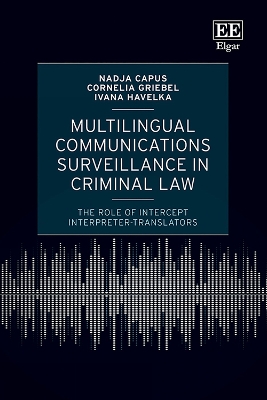Data Protection, Migration and Border Control
 portes grátis
portes grátis
Data Protection, Migration and Border Control
The GDPR, the Law Enforcement Directive and Beyond
Quintel, Teresa
Bloomsbury Publishing PLC
11/2022
288
Dura
Inglês
9781509959631
15 a 20 dias
Descrição não disponível.
Introduction: The Emergence of Multiple Function Creeps
1. The Developments Towards the Area of Freedom, Security and Justice and the Right to the Protection of Personal Data
I. Processing of Personal Data in the Law Enforcement Context
II. The Growth of Powers of the EU Agencies
III. The Case of EU Databases
IV. Conclusion
2. The End of Purpose Limitation
I. Interoperability in a Nutshell
II. Interoperability as a Logical Step
III. Law Enforcement Access to the Interoperability Components
IV. Law Enforcement Access in Light of Article 52(1) of the EU Charter
V. Access to the Interoperability Components by the Relevant EU Agencies
VI. Supervision of Processing within the Interoperable System
VII. Conclusion
3. The Overly Broad Application of Directive (EU) 2016/680
I. Directive (EU) 2016/680: Structure and Overview
II. Specific Rules under Directive (EU) 2016/680 for Data Protection in the Law Enforcement Context
III. Scoping Exercise: The Scope of Application of Directive (EU) 2016/680
IV. Provisions Specifically Designed for the Processing of Personal Data in the Law Enforcement Context
V. Data Subject Rights
VI. Obligations for Controllers and Security of Personal Data
VII. International Transfers of Personal Data
VIII. The Role of Data Protection Supervisory Authorities
IX. Existing EU Legal Acts and Commission Reports
X. Conclusion
4. The Blurred Line between EU Law Enforcement Agencies and EU Migration Agencies
I. Overview of the Respective Agencies
II. Access to EU Databases and the Interoperability Components by EU Agencies
III. The Fragmentation of Applicable Data Protection Rules
IV. Chapter IX of Regulation (EU) 2018/1725 on Operational Personal Data
V. The European Border and Coast Guard Agency Processing Personal Data: The Extended Mandate under the 2019 Regulation
VI. Europol and Eurojust: Solutions after the Adoption of Regulation (EU) 2018/1725
VII. Conclusion
Concluding Remarks
I. Outlook
1. The Developments Towards the Area of Freedom, Security and Justice and the Right to the Protection of Personal Data
I. Processing of Personal Data in the Law Enforcement Context
II. The Growth of Powers of the EU Agencies
III. The Case of EU Databases
IV. Conclusion
2. The End of Purpose Limitation
I. Interoperability in a Nutshell
II. Interoperability as a Logical Step
III. Law Enforcement Access to the Interoperability Components
IV. Law Enforcement Access in Light of Article 52(1) of the EU Charter
V. Access to the Interoperability Components by the Relevant EU Agencies
VI. Supervision of Processing within the Interoperable System
VII. Conclusion
3. The Overly Broad Application of Directive (EU) 2016/680
I. Directive (EU) 2016/680: Structure and Overview
II. Specific Rules under Directive (EU) 2016/680 for Data Protection in the Law Enforcement Context
III. Scoping Exercise: The Scope of Application of Directive (EU) 2016/680
IV. Provisions Specifically Designed for the Processing of Personal Data in the Law Enforcement Context
V. Data Subject Rights
VI. Obligations for Controllers and Security of Personal Data
VII. International Transfers of Personal Data
VIII. The Role of Data Protection Supervisory Authorities
IX. Existing EU Legal Acts and Commission Reports
X. Conclusion
4. The Blurred Line between EU Law Enforcement Agencies and EU Migration Agencies
I. Overview of the Respective Agencies
II. Access to EU Databases and the Interoperability Components by EU Agencies
III. The Fragmentation of Applicable Data Protection Rules
IV. Chapter IX of Regulation (EU) 2018/1725 on Operational Personal Data
V. The European Border and Coast Guard Agency Processing Personal Data: The Extended Mandate under the 2019 Regulation
VI. Europol and Eurojust: Solutions after the Adoption of Regulation (EU) 2018/1725
VII. Conclusion
Concluding Remarks
I. Outlook
Este título pertence ao(s) assunto(s) indicados(s). Para ver outros títulos clique no assunto desejado.
Introduction: The Emergence of Multiple Function Creeps
1. The Developments Towards the Area of Freedom, Security and Justice and the Right to the Protection of Personal Data
I. Processing of Personal Data in the Law Enforcement Context
II. The Growth of Powers of the EU Agencies
III. The Case of EU Databases
IV. Conclusion
2. The End of Purpose Limitation
I. Interoperability in a Nutshell
II. Interoperability as a Logical Step
III. Law Enforcement Access to the Interoperability Components
IV. Law Enforcement Access in Light of Article 52(1) of the EU Charter
V. Access to the Interoperability Components by the Relevant EU Agencies
VI. Supervision of Processing within the Interoperable System
VII. Conclusion
3. The Overly Broad Application of Directive (EU) 2016/680
I. Directive (EU) 2016/680: Structure and Overview
II. Specific Rules under Directive (EU) 2016/680 for Data Protection in the Law Enforcement Context
III. Scoping Exercise: The Scope of Application of Directive (EU) 2016/680
IV. Provisions Specifically Designed for the Processing of Personal Data in the Law Enforcement Context
V. Data Subject Rights
VI. Obligations for Controllers and Security of Personal Data
VII. International Transfers of Personal Data
VIII. The Role of Data Protection Supervisory Authorities
IX. Existing EU Legal Acts and Commission Reports
X. Conclusion
4. The Blurred Line between EU Law Enforcement Agencies and EU Migration Agencies
I. Overview of the Respective Agencies
II. Access to EU Databases and the Interoperability Components by EU Agencies
III. The Fragmentation of Applicable Data Protection Rules
IV. Chapter IX of Regulation (EU) 2018/1725 on Operational Personal Data
V. The European Border and Coast Guard Agency Processing Personal Data: The Extended Mandate under the 2019 Regulation
VI. Europol and Eurojust: Solutions after the Adoption of Regulation (EU) 2018/1725
VII. Conclusion
Concluding Remarks
I. Outlook
1. The Developments Towards the Area of Freedom, Security and Justice and the Right to the Protection of Personal Data
I. Processing of Personal Data in the Law Enforcement Context
II. The Growth of Powers of the EU Agencies
III. The Case of EU Databases
IV. Conclusion
2. The End of Purpose Limitation
I. Interoperability in a Nutshell
II. Interoperability as a Logical Step
III. Law Enforcement Access to the Interoperability Components
IV. Law Enforcement Access in Light of Article 52(1) of the EU Charter
V. Access to the Interoperability Components by the Relevant EU Agencies
VI. Supervision of Processing within the Interoperable System
VII. Conclusion
3. The Overly Broad Application of Directive (EU) 2016/680
I. Directive (EU) 2016/680: Structure and Overview
II. Specific Rules under Directive (EU) 2016/680 for Data Protection in the Law Enforcement Context
III. Scoping Exercise: The Scope of Application of Directive (EU) 2016/680
IV. Provisions Specifically Designed for the Processing of Personal Data in the Law Enforcement Context
V. Data Subject Rights
VI. Obligations for Controllers and Security of Personal Data
VII. International Transfers of Personal Data
VIII. The Role of Data Protection Supervisory Authorities
IX. Existing EU Legal Acts and Commission Reports
X. Conclusion
4. The Blurred Line between EU Law Enforcement Agencies and EU Migration Agencies
I. Overview of the Respective Agencies
II. Access to EU Databases and the Interoperability Components by EU Agencies
III. The Fragmentation of Applicable Data Protection Rules
IV. Chapter IX of Regulation (EU) 2018/1725 on Operational Personal Data
V. The European Border and Coast Guard Agency Processing Personal Data: The Extended Mandate under the 2019 Regulation
VI. Europol and Eurojust: Solutions after the Adoption of Regulation (EU) 2018/1725
VII. Conclusion
Concluding Remarks
I. Outlook
Este título pertence ao(s) assunto(s) indicados(s). Para ver outros títulos clique no assunto desejado.







